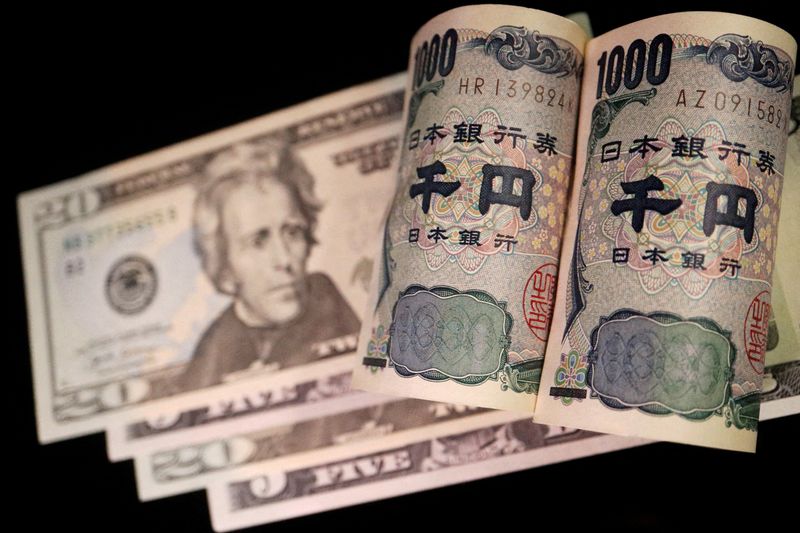
© Reuters. FILE PHOTO: Banknotes of Japanese yen and U.S. dollar are seen in this illustration picture taken September 23, 2022. REUTERS/Florence Lo/File Photo
By Ankur Banerjee
SINGAPORE (Reuters) -The yen languished near a four-month low against the U.S. dollar and a 16-year trough against the euro on Wednesday as traders wagered Japan’s monetary settings will remain accommodative even as the central bank ends its negative interest rate policy.
While the Bank of Japan on Tuesday ushered in the country’s first rate hike in 17 years, the central bank said it expected to maintain accommodative conditions for the time being, keeping pressure on the yen as U.S.-Japanese rate differentials remain stark.
On Wednesday, the yen weakened to a four-month low of 151.34 per dollar and was last off 0.26% at 151.23, with the multi-decade low of 151.94 within sight and the threat of intervention by Japanese authorities resurfacing.
“I think the focus is again around 152 levels,” said Christopher Wong, currency strategist at OCBC, adding that there was a fair chance of seeing some smoothing if dollar/yen continues to go higher towards 152.
Wong said the move for dollar/yen in the near term will be more a function of U.S. rates with the Federal Reserve decision due later on Wednesday.
Against the euro, the yen weakened to 164.35, its lowest since 2008, while against the pound, yen weakened to 192.37, its lowest since 2015. Japan markets are closed on Wednesday for a holiday.
In a historic shift from decades of massive monetary stimulus, the Japanese central bank on Tuesday ended eight years of negative interest rates and other remnants of unorthodox economic policy.
The Asian currency fell 1% against the dollar on Tuesday after the BOJ decision as most investors had already priced in a change, with analysts suggesting that the “dovish hike” cemented the view that the yen carry trade was far from over.
Low Japanese rates have made the yen the funding currency of choice for carry trades, in which traders typically borrow a low-yielding currency to then sell and invest the proceeds in assets denominated in a higher-yielding one.
The Australian dollar touched a more than three-week high on the yen at 98.86, having gained 0.7% overnight.
“The carry trade versus the major currencies continues to be in play and is expected to continue for a while,” Daniela Hathorn, senior market analyst at Capital.com said. “This means the yen is likely to see further weakness, especially if the other central banks continue to delay cutting rates.”
FED DAY
The main spotlight for the day remains on the Fed and although the central bank is not expected to move, its economic projections and comments from Chair Jerome Powell will be in focus.
Last week’s stronger than expected inflation reports led traders to further reduce their bets on rate cuts this year, with markets now pricing in 73 basis points (bps) of easing this year. At the start of the year, traders were pricing in 150 bps of cuts.
Traders are pricing in a 59% chance of the Fed starting its easing cycle in June, the CME FedWatch tool showed, sharply lower than earlier expectations.
“Given the recent rebound in inflation, the Fed decision will be closely scrutinised for whether there is a shift downwards in the median dot projection from 3 to 2 cuts this year,” said Nicholas Chia, Asia macro strategist at Standard Chartered (OTC:).
“If that happens, I think Powell will try to strike a dovish note in his press conference to prevent a further bear steepening of the US curve.”
The , which measures the U.S. currency against six rivals, rose to 0.019% to 103.87. The euro was steady at $1.08695.
The was 0.12% higher at $0.65395, while the New Zealand dollar was little changed at $0.6055, a day after Australia’s central bank held interest rates steady on Tuesday as expected, while watering down a tightening bias to say that it was not ruling anything in or out on policy.
















